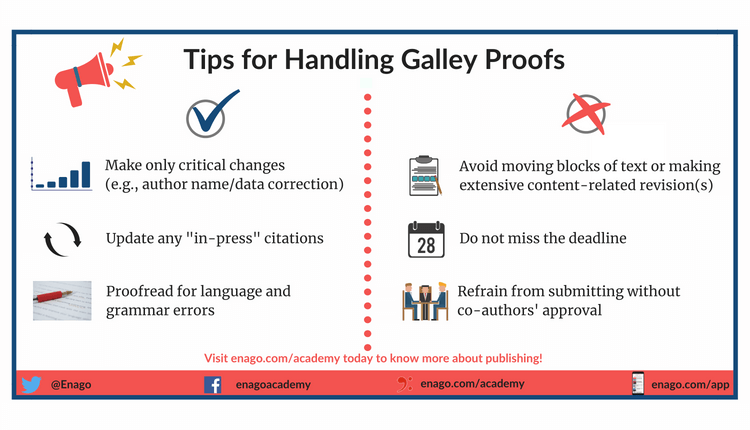Galley Proofs: The Final Step Before Manuscript Publication

The term “galley proof” comes from a time before electronic media, computers, and even typewriters, when type was actually hand set using wooden or metal blocks and placed into metal trays called “galleys.” These were then used to print single-column pages of type, or “proofs,” that the authors would check for any needed corrections to the text and send back to the printer. The printer would then painstakingly rearrange the blocks of type that needed to be corrected before printing again. What a time-consuming endeavor! Of course, now that everything is electronic, this process is simplified and less time-consuming, but the final manuscript text is still not published until there is one more author review, and hence the term “galley proof” is still used today.
When an author submits a manuscript to be published after peer review, there are several steps from submission to publishing that require interaction between journal staff and the author. Accepted manuscripts are edited and formatted by the journal’s editorial and production teams, who then present the author with a galley proof as one of the last steps before manuscript publication. This proof usually contains notes or queries from production staff and editors that need to be addressed and provides the author with clearly marked text indicating any changes made. The author has a final chance to accept or reject such changes, suggest minor revisions, and to answer any production related questions.
Galley Proof Protocols
Different publishers might handle this step differently, but the galley proof stage remains as the final review by the author before publication. Most journals provide electronic galley proofs to the corresponding authors who have the option to make suggestions using an online form or provide a separate pdf document that has all the author corrections noted. At this stage, only critical changes should be made, such as data corrections or names of missing authors. Extensive content related revisions initiated by authors at this stage are usually not encouraged. The corresponding author is expected to check with all the co-authors for their approval on any changes.
Related: Gone through your galley proofs and feeling happy already? Here’s how you should promote your research once it gets published
Since publishers have set publication timelines in place, they usually provide authors with deadlines of 24 hours to 72 hours to revise and return the proofs. An email with instructions is sent to the corresponding author when the proofs are ready to review. All revisions must be made on the proof document; the manuscript itself is not available at this point, and any major revisions suggested by authors are subject to approval by the journal’s editorial board.
For any publisher, a delay in returning revised galley proofs could postpone publication of the paper. In addition, there is no additional check by editorial staff; therefore any errors that are not corrected are, unfortunately, published. Authors must keep in mind that publishers often charge a fee for any alterations of the original manuscript text (this does not include corrections to their typographical or editing errors); therefore, authors must ensure to scrutinize the galley proofs well and include only the most critical and necessary changes at this point.
Recent Advances
Although the current system of checking and revising galley proofs works fine, is it as efficient as it could be? There could be further improvements made in the system and one company, TNQ, has offered easily accessible proofs which can be reviewed online. TNQ was founded in 1998 and serves some of the top publishers of scientific papers through the International Association of Scientific, Technical and Medical Publishers (STM). In 2012, the company created a new proofing dashboard called “Proof Central” that eliminates the usual PDF method of making corrections and saves time and money by providing an HTML version of the manuscript to the author. Heliyon, a new journal published by Elsevier, was the first to use this technology, and approximately one-fourth of all STM journals are now onboard.
The new Proof Central platform, which includes “Page Central,” makes the process easier for authors and provides a new version of the manuscript immediately after revisions are made with completely revised pagination. This process can often take several rounds of revisions between the author and production team; this new system eliminates this back-and-forth by allowing authors to see the changes immediately on newly paginated pages (eliminating the need for desktop publishing at this point) and reducing any possible errors made by production staff when incorporating PDF changes into the manuscript. The author then submits the final revised version to the production team.
This new technology is an obvious improvement in the process; however, whether using this or older protocols, authors must be aware of what changes are allowed at this stage.
Helpful Proofing Tips to Remember
Authors are urged to remember some very important tips when reviewing galley proofs:
- Pay close attention to deadlines; late submissions can delay publishing.
- Always check author names and affiliations.
- Make only critical changes that might affect conclusions (e.g., data revisions).
- Update any “in-press” citations if published at the proof stage.
- Correct typos.
- Do not make extensive text changes or move blocks of text.











Many thanks to you. I have indeed learnt a lot from you. I sincerely appreciate. Kudos.
Thank you for the insight